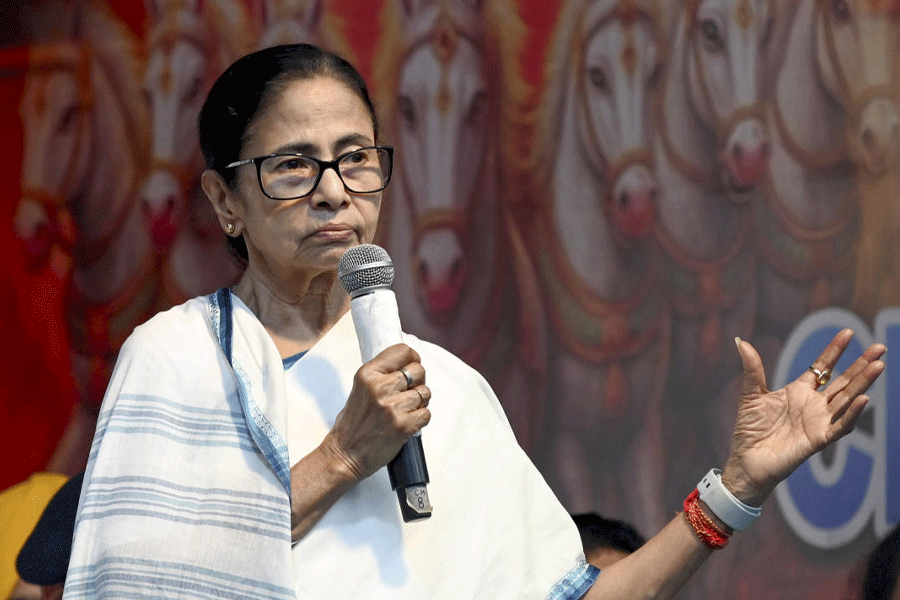 |
At first I thought it is the people of Mizoram who use bamboo to perform their celebrated dance, the Cheraw. After months of field research in remote forests of this small state in northeastern India, I know now it is the other way round. Through its intimate influence on the people, it is the bamboo that does its own dance on the mountains of Mizoram.
In March, Mizoram comes alive to the dance of the bamboos. Bamboos clap and clack to the rhythm of the Cheraw in the Chapchar Kut festival, bamboos are worked and woven into intricate handicrafts and other products in the state’s Bamboo Day exhibition, bamboos are cut and laid out to dry on the hill slopes where fields are being prepared for shifting cultivation, locally called jhum or law. As bamboos are integral to jhum farming, and jhum forms the mainstay of agriculture across the state, almost everywhere you look, you find bamboos. Yet, after being inseparable from Mizo life and culture for centuries, bamboos face new peril as politicians in the state push hard for a new policy of land use that aims to cover the hills with settled agriculture and industrial plantations and end shifting agriculture for ever.
On the first Friday of March, Mizo people across the state celebrate Chapchar Kut, before the farmers begin another spell of jhum. To see the bamboo dance during Chapchar Kut, I travelled to the state capital, Aizawl, from Dampa Tiger Reserve in western Mizoram. Here, as a wildlife scientist, I had studied the effects of shifting cultivation on forests and wildlife in the mid-1990s in a number of sites that I was re-surveying now almost two decades later. The sites include tropical rainforests with hoolock gibbons and hornbills as well as old jhum fields now covered with tall bamboo forests brimming with life. Leaving my research as a field biologist aside for a moment, I came to Aizawl for a glimpse into the cultural side of the bamboo story.
En route, on green, forest-covered hills, there are small jhum fields where slashed bamboos lie drying in the sun to be set alight later, even as smoke rises from other fields fired early, where the bamboos crackle and pop as they burn with consuming ferocity. Soon, in the ash-enriched soils, farmers will raise another season of crops, and when the spent fields are later abandoned for a new site the next year, the bamboos will rise again. The clearing of the forest is only temporary, the bamboo returns quickly and with vigour. My past field research showed that in five years, over 10,000 bamboo culms would regenerate per hectare (mainly Mautak, Melocanna baccifera) in the jhum fallows and the density of bamboo will increase even more if left uncut for longer.
On Chapchar Kut day in Aizawl, crowds pour into the Assam Rifles stadium, as young men and women who will perform the Cheraw stream onto the grounds below. The performers wear traditional dresses of bright red and green and black and white, striped and hatched with curiously bamboo-like designs, the men with dark cloth headbands patterned with perpendicular crossing stripes, the girls in bamboo-weave headbands topped by a ring of colourful red plumes.
The brightly-dressed youngsters carry stacks of green bamboo culms into the expansive grounds, placing them in sets of ten. Two culms about ten feet long placed in parallel a couple of metres apart set the bounds of the arena for the eight dancing girls; then, four paired culms are placed in perpendicular, to be held by eight crouching boys and clapped and beaten to the rhythm of the dance. As each group of Mizo girls and boys assembles with their placed bamboos on the open grounds, the sun-baked earth begins to bristle with colour and flicker with life.
It is nearly noon when the dance begins. Clap-clap-slap-slap: the bamboo sets the rhythm as the boys alternately clap the hand-held pair of bamboos and slap it on the culms on the ground. Arrayed in two rows of four each, the girls have the four spaces between the paired bamboos and the spaces outside to move in. And with grace, élan, and joy, they begin to dance, their feet stepping in and out of the culms, in sync with bamboo. The girls step and swirl and hop and turn, they toss their heads and swing their arms, face each other or turn away, dancing to the incessant beat of the bamboo culms worked by the boys at their feet.
To the clacking beat of the bamboo, the girls step and stomp and turn and toss, but inexorably each returns to the same spot where she started. The bamboo delimits the space they have to dance — step first here between the bamboo, and before the boys slap it shut, hop to the next space outside for the next steps, onto the space between the next pair of culms, and out, and back again. In my photographs the girls are frozen, heads aloft, long hair swinging, feet in the air, and the bamboo on the earth makes space for where they will land now, keeps space for later, and will make space once more where they began. Watching the Cheraw, I begin to think it is not unlike jhum itself, in which bamboo plays such a pivotal role. Mautak bamboos making space for this year’s cultivation, reserving shifting spaces for the next few years, always with the prospect of return to place within the bounds of the bamboo.
Out in the hills of Mizoram, I tried to understand this cycle of shifting cultivation through field research and by talking to farmers. After a span of five to 10 years, when forest vegetation and bamboo have recovered sufficiently in old jhum fields, farmers return to the same site again. The bamboo forest that has sheltered the soil for years from sun and erosion is then cut, dried, burnt, and replaced by crops, forming the cycle of cultivation and regrowth practised for centuries that has helped maintain extensive areas under bamboo and regenerating forests in Mizoram.
For every hectare of forest cut for jhum, at least five to 10 hectares are retained as forest in the landscape. Furthermore, jhum farmers also leave uncut many uncultivable strips of forest on ridges, in ravines and valleys, besides areas that form boundaries between fields. For local people as for forest plants and wildlife these uncut spaces serve as small but significant resource patches, natural buffers, and refugia in the landscape. In these areas, besides Mautak, other bamboos may be found: the stalwart Rawnal (Dendrocalamus longispathus), the giant Phulrua (D. hamiltonii), the sturdy Rawthing (Bambusa tulda), and forest bamboos such as the elegant Sairil (Melocalamus compactiflora), and the beautiful Chalthe (Schizostachyum polymorpha).
Even as jhum fires consume bamboos, opening fields for cultivation and nourishing their soil with ashes, the bamboo springs up in fields of the year past, it endures in refugia and ravines, it leaps towards the sky in the older abandoned fields. On the hill slopes, tall bamboo culms sway and clack and swing and dance, with grace and beauty, not unlike the girls of the Cheraw. The bamboos step aside temporarily for a farming season of a few months, only to return later and reclaim the land. As farmers move from bamboo patch to patch every year and return to each site after a few years, the bamboos first yield to farms, then reappear in the wake of the farmer, forming the perpetual cycle of field and fallow, of farmer and forest.
The spectacular Cheraw at Chapchar Kut seems emblematic of jhum, symbolizing the life and spirit of Mizoram that shifting cultivation embodies.











